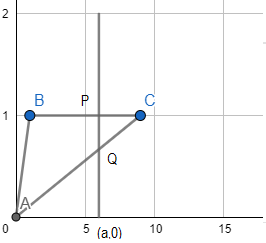Question
Question: Consider a \(\Delta ABC\) in the xy-plane with vertices A = (0,0), B = (1,1) and C = (9,1). If the l...
Consider a ΔABC in the xy-plane with vertices A = (0,0), B = (1,1) and C = (9,1). If the line x = a divides the triangle into two parts of equal area, then a equals:
(a) 3
(b) 3.5
(c) 4
(d) 4.5
Solution
Hint: Start by drawing the diagrams. Once you draw the diagram, try to find the area of one-half of the two parts and equate it with half of the area of the old triangle.
Complete step-by-step answer:
Now let us start the above question by making the diagram.

For triangle ABC, height is 1 unit, and the base BC is equal to 9-1 = 8 units. Therefore, the area of ΔABC is equal to:
ΔABC=21×b×h=21×8×1=4 unit2
Now for the new triangle formed due to the line x=a is ΔPQC whose base PC is equal to 9-a. Now to find the height PQ, we need to find the point Q.
So, we let the equation of the line AC be y=(x2−x1y2−y1)x . Which is:
y=91x...........(i)
Now, when x=a as in case of point q we get y=91a . Therefore, point Q is (a,91a) .
So, we can say that the height of ΔPQC is PQ which is equal to 1−91a . Therefore, the area of ΔPQC is:
ar(ΔPQC)=21×b×h=21×(1−91a)×(9−a)unit2=18(9−a)2
It is given in the question that ΔPQC should have half the area of ΔABC . Using this, we get
18(9−a)2=21×4
⇒(9−a)2=36
⇒(9−a)=6
⇒a=3
Therefore, the answer to the above question is option (a).
Note: Remember that you could have used the condition of equal parts by equating the area of ΔPQC and the other quadrilateral that is formed but for this you need to find the area of the quadrilateral, which is a complex task, so, we avoided it in the above solution.
